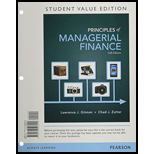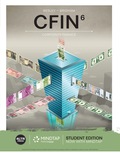
Integrative Case 1
Merit Enterprise Corp.
Sara Lehn, chief financial officer of Merit Enterprise Corp., was reviewing her presentation one last time before her upcoming meeting with the board of directors. Merit’s business had been brisk for the past 2 years, and the company’s CEO was pushing for a dramatic expansion of Merit’s production capacity. Executing the CEO’s plans would require $4 billion in new capital in addition to $2 billion in excess cash built up by the firm. Sara’s immediate task was to brief the board on options for raising the needed $4 billion.
Unlike most companies its size, Merit had maintained its status as a private company, financing its grow1h by reinvesting profits and, when necessary, borrowing from banks. Whether Merit could follow that same strategy to raise the $4 billion necessary to expand at the pace envisioned by the firm’s CEO was uncertain, although it seemed unlikely to Sara. She had identified the following two options for the board to consider.
Option 1: Merit could approach JPMorgan Chase, a bank that had served Merit well for many years with seasonal credit lines as well as medium-term loans. Lehn believed that JPMorgan was unlikely to make a $4 billion loan to Merit on its own, but it could probably gather a group of banks together to make a loan of this magnitude. However, the banks would undoubtedly demand that Merit limit further borrowing and provide JPMorgan with periodic financial disclosures so that it could monitor Merit’s financial condition as Merit expanded its operations.
Option 2: Merit could convert to public ownership, issuing stock to the public in the primary market. With Merit’s excellent financial performance in recent years, Sara thought that its stock could command a high price in the market and that many investors would want to participate in any stock offering that Merit conducted.
Becoming a public company would also allow Merit, for the first time, to offer employees compensation in the form of stock or stock options, thereby creating stronger incentives for employees to help the firm succeed. Sara also knew, however, that public companies faced extensive disclosure requirements and other regulations that Merit had never had to confront as a private firm. Furthermore, with stock trading in the secondary market, who knew what kind of individuals or institutions might wind up holding a large chunk of Merit stock?
To Do
- a. Discuss the pros and cons of option 1, and prioritize your thoughts. What are the most positive aspects of this option, and what are the biggest drawbacks?
- b. Do the same for option 2.
- c. Which option do you think Sara should recommend to the board, and why?
Want to see the full answer?
Check out a sample textbook solution
Chapter 2 Solutions
Principles of Managerial Finance, Student Value Edition Plus NEW MyLab Finance with Pearson eText -- Access Card Package (14th Edition)
Additional Business Textbook Solutions
Financial Accounting (12th Edition) (What's New in Accounting)
Marketing: An Introduction (13th Edition)
Financial Accounting, Student Value Edition (5th Edition)
Horngren's Accounting (12th Edition)
Engineering Economy (17th Edition)
- What is the duration of a four-year Treasury bond with a 10 percent semiannual coupon selling at par?arrow_forwardDon't used Ai solutionarrow_forwardYou bought a bond five years ago for $935 per bond. The bond is now selling for $980. It also paid $75 in interest per year, which you reinvested in the bond. Calculate the realized rate of return earned on this bond. I want to learn how to solve this on my financial calculator. Can you show me how to solve it through there.arrow_forward
- What are the Cases Not Readily Bound and what is a Dignity in a Research Study? What are the differences between Dignity in a Research Study and Cases Not Readily Bound? Please help to give examples.arrow_forwardWhat are the Case Study Research Design Components. Please help to give examplesWhat are the Case Study Design Tests and Tactics and how would they do?arrow_forwardDescribe some different types of ratios and how they are used to assess performance. Explain the components of the formula and the order of operations to calculate them. Discuss what these ratios say about the financial health of the organization. Determine why it is sometimes misleading to compare a company's financial ratios with those of other firms that operate within the same industry.arrow_forward
- Is there retained earning statement an important financial statement at the income statement and or the cash flows statement?arrow_forward2-13. (Term structure of interest rates) You want to invest your savings of $20,000 in government securities for the next 2 years. Currently, you can invest either in a secu- rity that pays interest of 8% per year for the next 2 years or in a security that matures in 1 year but pays only 6% interest. If you make the latter choice, you would then reinvest your savings at the end of the first year for another year. Why might you choose to make the investment in the 1-year security that pays an interest rate of only 6%, as opposed to investing in the 2-year security pay- ing 8%? Provide numerical support for your answer. Which theory of term structure have you supported in your answer? 2-14. (Yield curve) If yields on Treasury securities were currently as follows: TERM YIELD 6 months 1.0% 1 year 1.7% 2 years 2.1% 3 years 2.4% 4 years 2.7% 5 years 2.9% 10 years 3.5% 15 years 3.9% 20 years 4.0% 30 years 4.1% a. Plot the yield curve. b. Explain this yield curve using the unbiased…arrow_forwardWhat is the holistic case study format, could you please provide an example?arrow_forward
- Description Discuss in detail the Goal(s) of the firm. Additionally, List and discuss the 5 principles that form the foundations of finance. Lastly, List and discuss the various legal forms of business organizations.arrow_forwardWhat is the purpose of a case studty? Why is it important for researchers? Please give the examplesarrow_forwardInvestors in corporate zero-coupon bonds include all of the following EXCEPT: A: Tax-exempt retirement plans B: Conservative investors who want to lock-in their returns C: Investors who are saving for their children's college education D: Investors who do not need current cash flows E: All of the above are potential zero-coupon investorsarrow_forward
 Financial Accounting: The Impact on Decision Make...AccountingISBN:9781305654174Author:Gary A. Porter, Curtis L. NortonPublisher:Cengage Learning
Financial Accounting: The Impact on Decision Make...AccountingISBN:9781305654174Author:Gary A. Porter, Curtis L. NortonPublisher:Cengage Learning Financial AccountingAccountingISBN:9781305088436Author:Carl Warren, Jim Reeve, Jonathan DuchacPublisher:Cengage Learning
Financial AccountingAccountingISBN:9781305088436Author:Carl Warren, Jim Reeve, Jonathan DuchacPublisher:Cengage Learning
 Cornerstones of Cost Management (Cornerstones Ser...AccountingISBN:9781305970663Author:Don R. Hansen, Maryanne M. MowenPublisher:Cengage Learning
Cornerstones of Cost Management (Cornerstones Ser...AccountingISBN:9781305970663Author:Don R. Hansen, Maryanne M. MowenPublisher:Cengage Learning Survey of Accounting (Accounting I)AccountingISBN:9781305961883Author:Carl WarrenPublisher:Cengage Learning
Survey of Accounting (Accounting I)AccountingISBN:9781305961883Author:Carl WarrenPublisher:Cengage Learning





